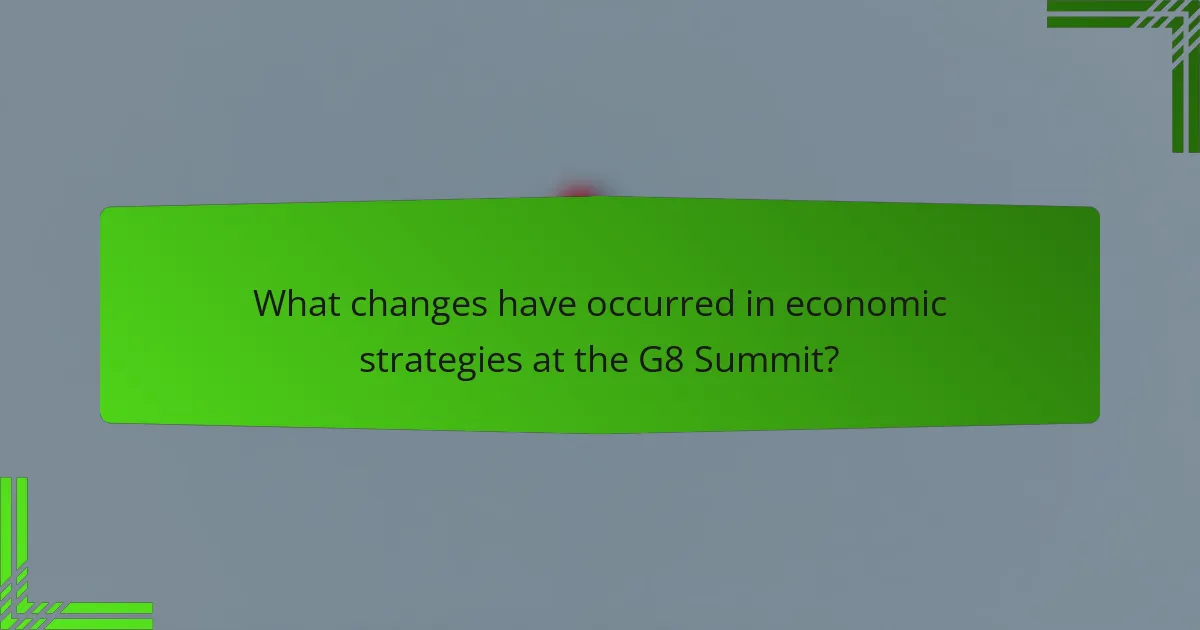The G8 Summit, a forum established in 1975 for industrialized nations to discuss economic stability and growth, has undergone significant evolution in its economic strategies over the decades. Key milestones include the expansion of discussions to debt relief in the 1980s, a focus on globalization in the 1990s, and an emphasis on the digital economy in 2001. Recent shifts highlight sustainable development and climate change as critical economic issues, alongside a commitment to international cooperation on trade and investment. The future of G8 economic strategies is expected to prioritize digital transformation, address income inequality, and enhance global governance in response to emerging economic challenges.

What are the key milestones in the evolution of economic strategies at the G8 Summit?
The key milestones in the evolution of economic strategies at the G8 Summit include the establishment of the forum in 1975. Initially, it focused on economic stability and growth among industrialized nations. In the 1980s, discussions expanded to include debt relief for developing countries. The 1990s saw a shift towards globalization and trade liberalization. In 2001, the G8 addressed the digital economy and technology’s role in economic growth. The 2008 financial crisis prompted a renewed focus on financial regulation and global economic governance. In 2015, the summit emphasized sustainable development and climate change as economic priorities. Each milestone reflects the changing global economic landscape and the G8’s adaptive strategies.
How have these milestones shaped global economic policies?
Milestones at the G8 Summit have significantly influenced global economic policies. They have established frameworks for international cooperation and economic governance. For example, the 2008 financial crisis prompted agreements for stricter financial regulations. These agreements aimed to enhance market stability and prevent future crises. Additionally, milestones have emphasized sustainable development and climate change. The G8 leaders’ commitments have led to policies promoting green technologies and renewable energy. Historical data shows that such commitments have shaped national policies worldwide. The G8’s influence has encouraged countries to adopt collaborative approaches to tackle global economic challenges.
What specific events marked significant changes in economic strategies?
The 2008 financial crisis marked a significant change in economic strategies. This event led to a global recession, prompting G8 leaders to adopt coordinated fiscal stimulus measures. The crisis revealed vulnerabilities in financial systems and resulted in regulatory reforms. The introduction of the Basel III framework aimed to strengthen bank capital requirements. Additionally, the G20 summit in 2009 expanded discussions beyond the G8, emphasizing global economic governance. These events collectively reshaped economic strategies towards more collaborative and regulatory approaches.
How did the G8 respond to global economic crises over time?
The G8 responded to global economic crises through coordinated policy measures and financial support initiatives. During the 2008 financial crisis, the G8 leaders implemented stimulus packages totaling over $5 trillion. They focused on stabilizing financial markets and preventing economic collapse. In 1997, during the Asian financial crisis, the G8 emphasized the need for international cooperation and financial reforms. They supported the International Monetary Fund (IMF) in providing assistance to affected countries. The G8 also addressed the Eurozone crisis in 2011 by advocating for fiscal consolidation and structural reforms. Over time, the G8’s responses evolved to include discussions on global governance and sustainable development. Each response was shaped by the specific economic context and challenges of the time.
What role does the G8 play in shaping international economic cooperation?
The G8 plays a significant role in shaping international economic cooperation through dialogue and consensus-building among major economies. This group consists of Canada, France, Germany, Italy, Japan, Russia, the United Kingdom, and the United States. The G8 addresses global economic issues by fostering collaboration on trade, investment, and financial stability.
It has historically influenced policies that promote sustainable development and poverty reduction. For instance, the G8’s Gleneagles Summit in 2005 focused on African development and debt relief, leading to commitments that significantly impacted global aid. The G8 also coordinates responses to economic crises, exemplified by its collective actions during the 2008 financial crisis.
Furthermore, the G8 facilitates discussions on emerging economic challenges, such as climate change and digital economy, which require cooperative solutions. Overall, the G8’s role in international economic cooperation is marked by its ability to convene leaders and shape a unified approach to complex global issues.
How does the G8 influence economic policies of member countries?
The G8 influences the economic policies of member countries through collaborative discussions and agreements. These meetings allow leaders to address global economic challenges collectively. The G8 establishes frameworks for economic cooperation. This includes guidelines on trade, investment, and financial regulation. Member countries often align their policies based on G8 agreements. For example, the G8’s focus on sustainable development shapes national economic strategies. The influence is evident in the adoption of common goals, such as reducing poverty and promoting growth. Historical instances, like the 2009 summit, emphasized coordinated responses to the financial crisis. This collaboration fosters a unified approach to economic governance among member nations.
What are the implications of G8 decisions on non-member countries?
G8 decisions significantly impact non-member countries through economic policies and international relations. Non-member countries often face changes in trade agreements influenced by G8 discussions. These decisions can lead to shifts in foreign investment patterns, affecting economic growth in non-member nations. Additionally, non-member countries may experience pressure to align with G8 priorities, such as climate change initiatives. This alignment can result in increased aid or sanctions depending on compliance. Historical examples include the G8’s influence on debt relief for African nations, which reshaped economic strategies. Overall, G8 decisions shape the global economic landscape, affecting non-member countries’ policies and development trajectories.

What changes have occurred in economic strategies at the G8 Summit?
Recent changes in economic strategies at the G8 Summit include a focus on sustainable development and global economic stability. The G8 has shifted towards addressing climate change as a critical economic issue. This change emphasizes the integration of environmental policies within economic frameworks. Additionally, there has been a stronger commitment to international cooperation on trade and investment. Enhanced discussions on digital economy and innovation have also emerged. These strategies aim to adapt to the evolving global economic landscape. The G8 now prioritizes inclusive growth to reduce inequality among nations. This evolution reflects the changing priorities of member countries in response to global challenges.
How have the objectives of the G8 evolved over the years?
The objectives of the G8 have evolved significantly since its inception. Initially, the G8 focused on economic issues and financial stability. Over the years, the agenda expanded to include broader global challenges. In the 1990s, topics like trade liberalization and development assistance gained prominence. By the 2000s, the G8 began addressing issues such as climate change and health crises. The 2005 summit emphasized Africa’s development and poverty reduction. More recently, the G8 has prioritized global security and counter-terrorism. Each summit reflects the changing landscape of international relations and economic priorities. The evolution demonstrates the G8’s adaptability to emerging global challenges.
What new economic challenges have prompted changes in G8 strategies?
The new economic challenges prompting changes in G8 strategies include global financial instability, rising inequality, and climate change. Global financial instability has led to economic crises that threaten growth. Rising inequality affects social cohesion and economic sustainability. Climate change poses risks to economies and necessitates sustainable development strategies. The G8 has adapted by prioritizing coordinated fiscal policies and sustainable practices. These adaptations aim to foster resilience against future economic shocks. The evolving landscape requires collaborative approaches to address these pressing issues effectively.
How has the focus on sustainability impacted G8 economic discussions?
The focus on sustainability has significantly influenced G8 economic discussions. It has led to the integration of environmental considerations into economic policies. Member countries increasingly prioritize sustainable development goals in their agendas. This shift has prompted discussions on green technologies and renewable energy investments. Economic strategies now emphasize reducing carbon emissions and promoting circular economies. The G8 has also addressed climate change as a critical economic challenge. Collaborative initiatives have emerged to support sustainable practices globally. This focus reflects a broader recognition of the economic risks posed by environmental degradation.
What are the current trends in economic strategies at the G8 Summit?
Current trends in economic strategies at the G8 Summit focus on sustainable development and climate change. Leaders emphasize the importance of green technology investments. They advocate for policies that promote economic resilience. There is a growing commitment to digital transformation in economies. Collaboration on trade policies is also a significant trend. The G8 is addressing global inequality through inclusive economic strategies. Recent discussions highlight the need for innovation in public-private partnerships. These trends reflect a response to global economic challenges and priorities.
What emerging economic issues are being addressed in recent summits?
Recent summits are addressing emerging economic issues such as global inflation, supply chain disruptions, and climate change. These topics are increasingly relevant due to the ongoing impacts of the COVID-19 pandemic. Global inflation has reached levels not seen in decades, affecting purchasing power worldwide. Supply chain disruptions have led to shortages of essential goods, impacting various industries. Climate change discussions focus on sustainable economic practices and investments in green technologies. These issues are critical as nations seek to stabilize their economies and promote recovery.
How has technology influenced economic strategies at the G8?
Technology has significantly influenced economic strategies at the G8. The G8 has integrated digital innovation into economic policies. This integration promotes global trade and investment. For instance, advancements in communication technologies have facilitated real-time data sharing. Enhanced data analytics allows for better decision-making among member countries. The G8 has also focused on cybersecurity as a critical economic issue. This focus aims to protect digital infrastructure and economic interests. Furthermore, technology has driven discussions on sustainable development. The G8 emphasizes the role of technology in addressing climate change and fostering green economies. These elements reflect the ongoing adaptation of economic strategies in response to technological advancements.

What are the future prospects for economic strategies at the G8 Summit?
The future prospects for economic strategies at the G8 Summit involve increased collaboration on global economic challenges. Member nations are likely to focus on sustainable development and climate change. Economic strategies may prioritize digital transformation and innovation. The G8 is expected to address income inequality and promote inclusive growth. Trade policies will likely evolve to reflect changing geopolitical dynamics. Enhanced cooperation on public health and pandemic preparedness may be prioritized. The G8’s role in global economic governance will continue to adapt to emerging economic powers. Historical context shows that the G8 has successfully navigated economic crises, indicating potential for effective future strategies.
How might global economic shifts affect future G8 strategies?
Global economic shifts will likely lead to significant adjustments in future G8 strategies. For instance, the rise of emerging markets may shift focus from traditional Western economies. The G8 may prioritize inclusive growth to address global inequality. Additionally, changing trade dynamics could necessitate new trade agreements among member nations. Economic instability from geopolitical tensions may prompt G8 leaders to enhance collaboration on security and economic resilience. Historical data shows that past economic crises have influenced G8 agendas, such as the 2008 financial crisis leading to increased emphasis on financial regulation. These shifts reflect the G8’s adaptability to evolving global economic landscapes.
What potential challenges could the G8 face in the coming years?
The G8 could face several potential challenges in the coming years. One major challenge is geopolitical tensions among member countries. These tensions can disrupt collaborative efforts and decision-making processes. Economic disparities between member nations may also pose a significant challenge. Countries with varying economic strengths may struggle to reach consensus on fiscal policies. Climate change and environmental sustainability will likely demand urgent attention. The G8 must address these issues to maintain global leadership in environmental policy. Additionally, evolving global trade dynamics could create friction among member states. Trade wars and protectionist policies could hinder economic cooperation. Lastly, technological advancements may lead to regulatory challenges. The G8 will need to adapt to rapid changes in technology and digital economies. These challenges could significantly impact the effectiveness of the G8 in achieving its goals.
How can the G8 adapt to changing global economic landscapes?
The G8 can adapt to changing global economic landscapes by enhancing collaboration among member nations. This includes sharing best practices for economic resilience. Strengthening trade agreements can also help G8 countries respond to market fluctuations. Additionally, investing in technology and innovation will foster economic growth. The G8 should prioritize sustainable development to address long-term global challenges. Regular assessments of economic policies will ensure they remain relevant. Engaging with emerging economies can provide new opportunities for growth. Historical examples, such as the G20’s response to the 2008 financial crisis, illustrate the importance of adaptive strategies.
What best practices can be derived from the evolution of G8 economic strategies?
Best practices from the evolution of G8 economic strategies include collaborative decision-making, transparency in policy formulation, and adaptability to global economic changes. Collaborative decision-making fosters consensus among member nations, enhancing the effectiveness of strategies. Transparency in policy formulation builds trust and allows for better engagement with stakeholders. Adaptability ensures that strategies remain relevant in the face of shifting global economic conditions. Historical evidence shows that successful G8 initiatives, such as the 2009 commitment to fiscal stimulus during the financial crisis, exemplify these best practices. These approaches have led to more resilient economic policies and improved international cooperation.
How can member countries implement successful strategies from G8 discussions?
Member countries can implement successful strategies from G8 discussions by adopting collaborative frameworks. These frameworks should focus on shared goals established during the G8 meetings. Countries must prioritize communication and transparency among themselves. They should also align their national policies with the agreed-upon strategies. This alignment can enhance the effectiveness of collective actions. Regular assessments of progress are essential to ensure accountability. Additionally, countries can leverage best practices shared during the discussions. Historical examples, such as the G8’s commitment to addressing global economic challenges, demonstrate the effectiveness of these approaches.
What lessons can be learned from past G8 economic strategies?
Past G8 economic strategies highlight the importance of international cooperation in addressing global financial challenges. Collaborative approaches can enhance economic stability and growth. The 2008 financial crisis response demonstrated the effectiveness of coordinated policy measures among G8 nations. It emphasized the need for timely interventions and regulatory reforms. Lessons also include the significance of addressing inequality and promoting sustainable development. Initiatives like the G8’s focus on Africa showed the impact of targeted aid and investment. Overall, past strategies reveal that adaptability and inclusiveness are crucial for future economic resilience.
The primary entity of the article is the evolution of economic strategies at the G8 Summit, which encompasses key milestones and changes since its establishment in 1975. The article outlines significant developments, including the G8’s initial focus on economic stability, the expansion to issues like debt relief and globalization, and the response to crises such as the 2008 financial downturn. It also highlights how these milestones have shaped global economic policies, influenced member countries, and impacted non-member nations, while addressing emerging challenges like climate change and digital transformation. Overall, the article provides a comprehensive overview of the G8’s adaptive strategies in the context of evolving global economic landscapes.